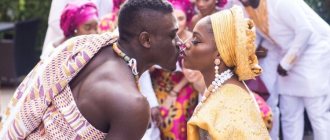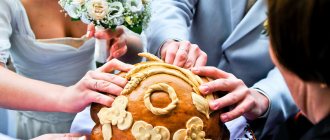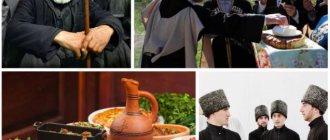Armenian wedding... What could be more beautiful and larger-scale than this great holiday, filled with positive emotions, fun and many national rituals and customs? For a long time, Armenians have sacredly respected their traditions and sincerely believe that their observance brings happiness and prosperity to the newly born family.
A lot of people are always invited to the celebration: from the closest to the most distant relatives. You will be welcome, even if you barely know the bride and groom. Those who have at least once had the opportunity to attend an “Armenian wedding” will no doubt agree that they have never seen a more fun and memorable wedding. Armenians are friendly and peace-loving people who have great respect for the process of creating a family and having children.
How does matchmaking and engagement work?
Among Armenians, the right to choose a bride belongs to the groom’s parents, or more precisely, to his mother. The woman is very enthusiastic about finding a suitable match for her son, taking into account not only the girl’s background, but also her health, hard work and education. There are no special requirements for external evaluation criteria.
Next, the groom’s mother negotiated her choice with her husband, after which a mediator was selected among close relatives. Her goal was to negotiate over the young man's intentions to marry the girl. If a positive response was received from the bride's mother, the matchmaking could take place.
The Armenian wedding ceremony begins with matchmaking, which is attended exclusively by men. They discuss the purpose of their visit with the bride’s relatives and ask for approval for their children’s marriage. But according to tradition, the first time a positive answer from the girl’s parents could not be given. This meant that a second visit could not be avoided.
After successful matchmaking comes an equally important part of preparing for the wedding - engagement.
The expected engagement day is agreed upon in advance. Many relatives gather at the groom's house, bringing with them various gifts for the young bride.
First, the feast is held at the groom's place, and a rich festive table is laid out. Later, the same event takes place in the bride’s house, with the same characters.
A respected relative (kavor) from the groom’s side takes the bride and her bridesmaids out and places them at the groom’s table. A young girl accepts gifts from guests. After this, the newly minted groom puts a wedding ring on his beloved’s finger. The engagement is accompanied by songs, dances and fun competitions.
After the entertainment part of the holiday has come to an end, the kavor and the groom's father decide on what day the wedding celebration will take place.
Matchmaking
The first stage is extremely important. The matchmakers gather in the dark and come to the bride's parents. They arrive in the dark so that no one else knows about the refusal if it occurs. Matchmaking is divided into three visits. On their first visit, the matchmakers receive a humorous refusal. If the bride's parents agree immediately, it means that not everything is all right with the girl (perhaps she is ugly or has been around too long). According to custom, when parents refuse, citing the young age of the bride and groom, there will be no second visit, this refusal is serious and cannot be appealed.
Helping carrot seeds sprout faster: two proven methods from gardeners
By stopping cooking on weekdays, a woman improved her life and saved money
I make my own lip balm that protects from the sun: I use it all year round
If all is well, the matchmakers come a second time. On this visit, matchmaking takes place in the presence of the young fathers, and lavash is broken in the presence of the priest. In this way, two families are united and blessed with friendship and good family relationships.
The third visit of matchmakers is called hoskap. A meeting takes place among close relatives, the bride is given gifts, and a rich table is set. Gifts are also given to the mother of the bride, usually jewelry. From this moment on, the newlyweds are considered engaged. They are not allowed to see each other before the wedding. However, with the permission and supervision of the bride's mother, the groom can visit his beloved alone. They are not allowed to touch each other.
Interesting fact: if there are several candidates for the bride’s hand, then gifts are collected from them. The one whose gift the girl chooses will become her groom.
Take your own socks: rules for choosing shoes for training
The secret of Alferova’s happy brother is “For me he is a man, not an actor”
Cindy Crawford is unrecognizable as a child. Cute photos from the 1960s
Wedding preparations
The traditions and customs of the Armenian people require a number of mandatory events to be held before celebrating a wedding.
The first obligatory ritual is the bride's viewing.
It is held with the purpose that the newlyweds have the opportunity to see each other before the wedding. To do this, the future groom and his close relative make a visit to the bride’s house, while treating the girl’s mother or sisters to sweets. Every other day, sweets are distributed to neighboring children.
To ensure that the celebration takes place in an organized manner, a ritual called “kyasum trel” is performed. During it, the groom and the groom's father negotiate all the expenses for the holiday, the number of people, the menu, etc. Next comes the stage of active preparation, which includes, first of all, an agreement on the date of the wedding in the church.
Issues regarding the number of guests are also discussed. The venue for the celebration is selected and the wedding program is drawn up.
Wedding celebration
The tradition of celebrating a wedding for three days has survived to this day, although previously it could last for a week if the material wealth of the newlyweds’ families allowed it.
The Armenian wedding scenario requires the observance of a number of rituals. For example, the bride and groom must take a bath before the ceremony, which was a symbol of purification before marriage. The young man's bathing took place in a stable, his friends helped him, and the bride bathed at home with the help of her friends. This solemn ritual was accompanied by singing and dancing.
- Traditionally, the wedding celebration was scheduled for the autumn or winter period, when the harvest was already over. An Armenian wedding is distinguished by the obligatory presence of the seated father and mother - Kavor and Kavorkin - who are the main persons of the ceremony. The groom's brother - azzabashi - was appointed the main groom. The toastmaster had to lead the wedding festivities, making toasts, forcing everyone to drink, and overseeing the general fun.
- The father of the newlywed was considered the host of the wedding. Wedding tables were set both in the house of the groom and in the house of the bride, and the feast began in them simultaneously in the morning.
- Previously, the bride was not allowed to participate in the wedding feast; she could not be present at the common table. She was supposed to be in a curtained corner, which was decorated with various amulets - it was believed that they protected the bride from the evil eye and damage.
- After feasting at the groom's house, the wedding procession headed to the bride's house, carrying her wedding dress on a large tray. At the gates of the house, the procession was met by the girl’s relatives, demanding a ransom for her. When the groom finally met his bride, everyone sat down at the tables again and began to feast in the bride's house, this feast took place over several hours.
- In the evening, the guests went home, and the groom was supposed to spend the night with the main groom. The bride was supposed to spend the night in the company of her girlfriend or sister.
- The second day of the wedding celebration began with the preparation of the bride: her bridesmaids dressed her in a wedding dress, this action was accompanied by sad melodies played on the Armenian zurna. The dress, made from expensive fabrics, was practically no different in style from everyday clothes; the newlywed’s face must certainly be covered with a veil.
- You can see what the bride's dress looks like in the photo.
- A married man who already has children was supposed to bring the bride out in a wedding dress and hand her over to the groom. He should have wished the young couple happiness, health and many children.
- The wedding ceremony was considered an obligatory ritual of an Armenian wedding; without this, the newlyweds would not have the opportunity to lie down on the marriage bed.
- Only on the third day of the wedding the girl was transported to her husband’s house. In the morning, the whole family of the young man followed his young wife to her parents’ house. The father passed her from hand to hand to her husband, and the son-in-law received orders from him to protect and take care of his wife.
- The custom has been preserved unchanged, according to which the mother of the groom, when meeting the newlyweds, threw lavash over their shoulders, and sprinkled a mixture of grain, raisins, sweets and nuts on their heads. Two plates taken from the bride's house are placed under the feet of the newlyweds, which they must break. According to custom, the new husband is supposed to be the first to break the dish.
- Armenian wedding customs are associated with abundant food, ritual chants and lively dances. The tables were literally bursting with pickles, good wine and cognac, oriental sweets and fruits. Witty ornate toasts and congratulatory speeches in honor of the newlyweds were heard throughout the entire celebration.
- According to the old tradition, the newlyweds must spend the first night alone in the house, and all household members must spend the night with relatives or neighbors. In the morning, the young husband should have hidden himself with one of his relatives, and only in the evening, when he was brought home, should he, in embarrassment, kiss his parents’ hands. Now this tradition has practically become obsolete.
Carrying out an Armenian wedding
In Armenia, a wedding without a wedding is not recognized, so this ceremony is mandatory for a young couple. It is very important that no one passes between the newlyweds during the process.
Considering that there are a lot of people, this is watched by young people from the groom’s side – the Kavors.
During the wedding, one of the Cavors must hold a crossed sword and scabbard over the heads of the couple. This ritual is associated with the fact that metal protects the couple from evil spirits. It is worth mentioning another important and quite interesting ritual.
During the ceremony, the priest tied special cords on both the bride and groom's hands (sometimes necks), the ends of which were covered with wax. This cord has a name - narot. No one except a clergyman can remove it independently. This action did not allow the spouses to have close relationships; they had to wait until the cord was untied. After the main event, the wedding, comes the official part of the celebration - the wedding.
This event requires the newlyweds and their relatives to observe a huge number of rituals that help the couple to be happy in marriage.
The wedding took place in two houses, and it began in the morning. In the groom's house, a bull was traditionally slaughtered, whose neck was decorated with apples. During this action, young girls sang songs and danced.
And at this time the groom had to make an incision on the bull’s neck with a knife, and then put the knife in his pocket.
The kavor smeared the groom's forehead with fresh blood. The boy's mother had to take a thread and soak it in this blood. The thread was kept until the wedding night.
Armenians associate such an unusual ritual with childbirth, since the bull itself serves as a symbol of fertility. The newlyweds are greeted by their mother-in-law in the house of their future spouse. She gives the bride and groom a spoonful of honey and places lavash on their shoulders. When the newlyweds enter the house, they are sprinkled with raisins and flowers from baskets. This custom gives young people a prosperous and peaceful life.
In the bride's house there is a big feast, toasts are made, and music is played.
But the musical accompaniment has a sad motive, since the girl’s parents are saddened that their now adult daughter is leaving her home. At the end of the feast, the bride and groom dance. At the end of the dance, the girl’s father joins the hands of the young couple and blesses the couple.
After this, everyone returns to the groom’s house, where most of the entire celebration in honor of the birth of a young family takes place. The bride's brother tries to prevent the couple from leaving the house, thereby protesting and wanting the sister to stay in this house.
Cavor comes to an agreement with his brother and gives him a bride price. It is impossible to say unequivocally that the wedding traditions of the people belong only to Armenians, because their festive rituals are mixed with the rituals of other peoples. It is worth noting that the Armenian feast began with toasts, which honored the memory of deceased relatives. After this, it was only possible to congratulate the newlyweds and make toasts in their honor.
According to old customs, the bride was not given a place at the table; she stood in the corner behind a beautiful curtain, surrounded by a large number of amulets and amulets.
Now, of course, the wedding takes place in a more civilized manner, and the bride sits at the wedding table next to her newly-made husband.
The holiday was accompanied by cheerful songs and dances. During the celebration, the guests presented the newlyweds with gifts and money.
The guests who represented the groom's side had fun from the heart, thereby expressing their joy that their groom had found such a wonderful bride. The bride's relatives were more reserved because they were sad and sad that the bride was leaving her father's house. Modern Armenian traditions are no longer much different from those to which we are accustomed. But still, some rituals were preserved and passed on from generation to generation.
An experienced toastmaster who is well versed in national traditions is invited to the celebration.
Groom's preparations
A kavor—the imprisoned father—is appointed in advance. The ceremony of the groom's transition to family life takes place in his house. The future head of the family and his unmarried friend are placed back to back in a large basin. Water is poured over the backs as a sign of the separation of single life from family life. After the ceremony, the groom is dressed with dancing and singing. A bouquet of willow branches is decorated with ribbons and decorated with sweets, apples and pomegranates. At modern weddings, willow branches are often replaced with a sword. It is called “Arsaniki Tsar” - a symbol of well-being and prosperity in the future family.
“Spring is coming”: Nastya Kamenskikh gave advice to novice sports fans
“Typical French - they don’t care”: the world champion gave up in the middle of the race
Long-term weather forecast for March 2021 by region (works on site)











